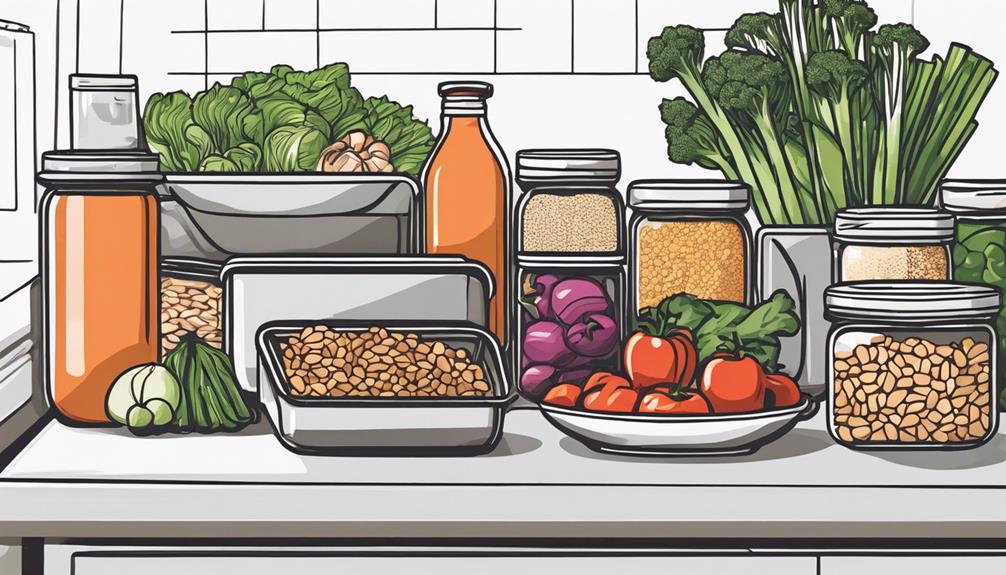When it comes to managing your diabetes with ease, think of affordable diabetes-friendly recipes like a well-oiled machine. You're looking to keep your health in check without breaking the bank, right?
Well, here's the kicker – by implementing simple yet effective strategies, you can whip up delicious meals that won't empty your wallet.
So, let's explore some budget-friendly tips that will not only support your health goals but also help you save some serious cash along the way.
Key Takeaways
- Utilize budget-friendly proteins like eggs and canned tuna for cost-effective meals.
- Plan ahead and create a shopping list based on meal prep strategies to save money.
- Incorporate seasonal produce for variety and nutritional benefits while managing costs.
- Make healthy recipe adjustments using plant-based proteins and whole grains for diabetic-friendly meals.
Meal Planning Strategies

When planning your meals to manage diabetes on a budget, consider incorporating a variety of nutritious ingredients for balanced nutrition. Portion control is essential in managing blood sugar levels effectively. By controlling portion sizes, you can better regulate your carbohydrate intake, which directly impacts your blood glucose levels. Understanding carb counting is crucial for individuals with diabetes. It allows you to monitor your carbohydrate consumption, making sure you stay within your recommended daily limits.
To implement portion control effectively, try using smaller plates to visually trick your mind into thinking you're eating more. Additionally, measuring your food with cups or a food scale can help you stay on track with your portions.
When carb counting, focus on consuming complex carbohydrates like whole grains, fruits, and vegetables instead of simple sugars. These foods provide essential nutrients and fiber, promoting better blood sugar control. By mastering portion control and carb counting, you can create diabetes-friendly meals that are both nutritious and budget-friendly.
Smart Grocery Shopping Tips
To make the most of your grocery shopping experience while managing diabetes on a budget, focus on selecting nutrient-dense foods that align with your dietary needs and financial goals.
When shopping, opt for budget-friendly proteins such as eggs, canned tuna, or dried beans, which aren't only economical but also excellent sources of protein. Consider buying in bulk or choosing store-brand options to save money without compromising on quality.
Another smart grocery shopping tip is to plan your meals ahead of time and create a shopping list based on your meal prep strategies. This not only helps you stay organized but also prevents impulse buys that can strain your budget.
Look out for sales, discounts, and coupons on diabetic-friendly foods to maximize savings. By being mindful of your choices and planning your shopping trips strategically, you can effectively manage your diabetes while keeping your grocery expenses in check.
Utilizing Seasonal Produce

When planning your diabetes-friendly meals on a budget, incorporating fresh seasonal fruits and vegetables can be a smart choice. By utilizing produce that's in season, you not only enhance the flavor of your dishes but also benefit from the peak nutritional content of these ingredients.
Explore different recipes that highlight the versatility and health advantages of cooking with seasonal produce.
Fresh Seasonal Fruit Options
Exploring the vibrant selection of fresh seasonal fruits can add a burst of flavor and nutrients to your diabetes-friendly meals while staying within your budget. For budget-friendly fruit salad ideas, consider combining seasonal fruits like berries, apples, and citrus fruits for a colorful and refreshing dish.
These fruits aren't only delicious but also packed with vitamins, fiber, and antioxidants that are beneficial for managing diabetes. Additionally, seasonal fruit smoothies can be a great diabetic-friendly option. Blend fruits like strawberries, peaches, or melons with low-fat yogurt or almond milk for a nutritious and satisfying drink.
Cooking With Seasonal Veggies
Consider incorporating a variety of seasonal veggies into your meals to enhance flavor and nutrition while sticking to your budget. Here are some tips to help you make the most of seasonal produce:
- Experiment with Roasting Techniques:
Try roasting seasonal veggies like Brussels sprouts, butternut squash, or cauliflower to bring out their natural sweetness and add a delicious caramelized flavor.
- Explore Flavor Pairings:
Pair seasonal veggies like zucchini with tomatoes, bell peppers, and basil for a refreshing summer salad. Or combine sweet potatoes with cinnamon and nutmeg for a cozy fall side dish.
- Try Different Cooking Methods:
From stir-frying to grilling, explore various ways to cook seasonal veggies to keep your meals exciting and full of flavor.
- Mix and Match:
Combine different seasonal veggies in a single dish to create colorful and nutrient-packed meals that are both tasty and budget-friendly.
Benefits of Seasonal Eating
Opt for seasonal produce to maximize freshness, flavor, and nutritional value in your meals while staying mindful of your budget. Seasonal benefits extend beyond just cost-effectiveness. Seasonal fruits and vegetables are harvested at their peak, ensuring that you get the highest nutritional content from your produce.
By incorporating seasonal ingredients into your meals, you can enjoy a wide variety of flavors and textures throughout the year. Seasonal cooking allows you to experiment with different ingredients, keeping your meals exciting and diverse. Additionally, seasonal produce tends to be more abundant, making it easier to find fresh ingredients at affordable prices.
Embracing seasonal eating not only benefits your health but also supports local farmers and reduces environmental impact.
Cooking in Batches

To make the most of your time and resources when preparing diabetes-friendly meals, consider cooking in batches to streamline your cooking process and ensure you have healthy options readily available. Batch cooking benefits include saving time, reducing stress, and helping you stick to your diabetes management plan.
Here are some tips to help you enjoy the benefits of batch cooking:
- Plan Ahead: Select recipes that freeze well and gather all ingredients before starting.
- Use Freezer-Friendly Containers: Invest in containers that are suitable for freezing to maintain the quality of your meals.
- Label and Date: Properly label and date your meals before storing them in the freezer to ensure easy identification.
- Thaw Safely: Thaw your frozen meals in the refrigerator overnight or use the defrost setting on your microwave for safe and convenient meal prep.
Substituting Ingredients Wisely
When managing diabetes, making wise ingredient substitutions can greatly impact your health. Opting for smart swaps can help you create recipes that are diabetes-friendly while still being delicious.
Smart Ingredient Swaps
Considering ingredient swaps for healthier alternatives in your diabetes-friendly recipes can significantly impact the nutritional value of your meals without compromising taste or texture. Making smart ingredient swaps can help you create delicious dishes while keeping your blood sugar levels in check. Here are some flavorful substitutes and ingredient hacks to enhance your recipes:
- Using Greek yogurt instead of sour cream for added protein and less fat.
- Opting for whole wheat flour instead of white flour to increase fiber content.
- Swapping out sugar with natural sweeteners like stevia or erythritol for lower calorie counts.
- Incorporating mashed avocado in place of butter for heart-healthy fats and creaminess.
These simple swaps can elevate the health benefits of your meals without sacrificing flavor.
Healthy Alternatives for Diabetes
Enhancing your diabetes-friendly recipes with smart ingredient swaps can empower you to make healthier choices without compromising taste or texture.
When looking for sugar alternatives, consider using stevia, erythritol, or monk fruit sweeteners instead of regular sugar. These options can satisfy your sweet tooth without causing spikes in blood sugar levels.
Additionally, incorporating low carb options like almond flour, coconut flour, or flaxseed meal can help reduce the overall carbohydrate content of your dishes. These ingredients not only add a nutty flavor but also provide essential nutrients and fiber.
Cost-Effective Recipe Adjustments
To optimize your budget while maintaining the health benefits of your recipes, judiciously substituting ingredients can be a strategic approach. When looking to make cost-effective recipe adjustments while keeping your meals diabetes-friendly, consider the following tips:
- Use Whole Grains: Swap out refined grains with whole grains like brown rice or quinoa for added fiber and nutrients.
- Choose Lean Proteins: Opt for budget-friendly protein sources such as beans, lentils, or canned tuna instead of pricier meats.
- Explore Plant-Based Options: Incorporate more plant-based meals using ingredients like tofu or legumes to cut costs while boosting nutrition.
- Experiment with Spices: Enhance flavors without extra cost by using spices and herbs to reduce the need for added sugars or unhealthy fats.
Embracing Plant-Based Proteins
When looking to increase the nutritional value of your meals while managing a budget, incorporating plant-based proteins can be a wise and cost-effective choice. Plant-based protein sources like beans, lentils, tofu, and quinoa aren't only affordable but also packed with essential nutrients such as fiber, vitamins, and minerals. These ingredients can be versatile additions to your meals, helping you create balanced dishes that support your diabetes management goals.
To ensure that your meals are balanced and provide adequate nutrition, consider incorporating a variety of plant-based protein sources throughout your day. For example, start your morning with a tofu scramble or add chickpeas to your salads for lunch. Including a mix of legumes, nuts, seeds, and whole grains in your diet can help you meet your protein needs while keeping your meals interesting and flavorful.
Avoiding Pre-Packaged Foods

Embracing a diet focused on whole foods can be a key strategy for managing diabetes and improving overall health. When aiming to avoid pre-packaged foods, consider the following DIY cooking strategies:
- Cook from Scratch: Opt for homemade alternatives to pre-packaged meals. Cooking from scratch gives you control over the ingredients and allows you to avoid added sugars, unhealthy fats, and excessive salt commonly found in processed foods.
- Plan Ahead: Take some time to plan your meals for the week. This way, you can prepare nutritious dishes using fresh ingredients instead of relying on convenient but less healthy pre-packaged options.
- Batch Cooking: Prepare large batches of meals and freeze portions for later use. This helps you avoid the temptation of resorting to pre-packaged convenience foods on busy days.
- Learn Basic Cooking Skills: Developing basic cooking skills can empower you to create simple, diabetes-friendly meals from scratch without the need for pre-packaged items.
Frequently Asked Questions
Can These Diabetes-Friendly Recipes Be Easily Adapted for Different Dietary Restrictions, Such as Gluten-Free or Vegan Diets?
When adapting flavors for different dietary needs like gluten-free or vegan diets, you can customize ingredients in diabetes-friendly recipes. Substituting items like gluten-free flour or plant-based proteins ensures these dishes cater to various dietary restrictions effectively.
Are There Any Tips for Incorporating More Physical Activity Into a Diabetes-Friendly Meal Plan?
Want to jazz up your diabetes-friendly meal plan? Incorporating exercise can turbocharge your efforts. Pair meal planning with short walks after eating. This not only aids digestion but also helps manage blood sugar levels.
How Can I Ensure That I Am Getting a Balanced Mix of Nutrients in These Recipes to Support My Overall Health, in Addition to Managing My Diabetes?
To ensure nutrient balance and support your health in recipes, focus on incorporating a variety of colorful fruits and vegetables, lean proteins, whole grains, and healthy fats. Adapt recipes to fit dietary restrictions by swapping ingredients smartly.
Are There Any Recommendations for Portion Control or Serving Sizes When Preparing These Recipes?
When preparing these recipes, remember to focus on portion control for healthy servings. Adapt recipes to meet dietary restrictions. Visualize balanced plates to support overall health and diabetes management. Enjoy the freedom of creating meals that nourish your body.
Do You Have Any Suggestions for Making These Diabetes-Friendly Recipes More Appealing to Picky Eaters or Children?
To make diabetes-friendly recipes more appealing to picky eaters, get creative with flavors and textures. For children, try fun presentations like using cookie cutters for shapes or arranging food in a visually appealing way to encourage eating.
Conclusion
In conclusion, by following these budget-friendly tips for diabetes-friendly recipes, you can't only save money but also take control of your health.
Just like carefully selecting each ingredient to create a delicious meal, making conscious choices in your diet can nourish your body and improve your overall well-being.
Remember, every small step towards a healthier lifestyle is a step in the right direction. Keep cooking, keep exploring, and keep prioritizing your health.